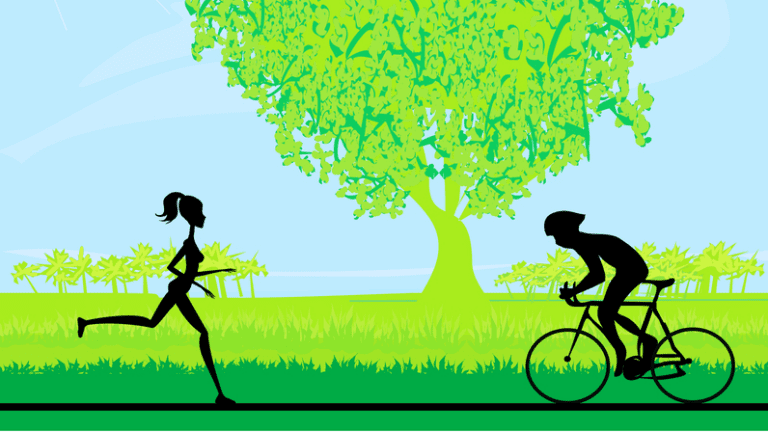Running and cycling both rely on the lower body as primary movers, but the mechanics of running and cycling are different and use the muscles in different ways.
During running, the muscles of the lower body help to move the body through four stages — heel strike, single limb support, push-off and leg swing. Cycling has only two stages, the power phase and the recovery phase, and it’s during the power phase of cycling that the leg muscles are essential.
Sustained high intensity via cycling is safer and able to be sustained for much longer distances due to a lesser impact on the joints, and this results in a much better output when executed. However, you need to ride further than you run because of that fact. According to Dr. Edward Coyle from the University of Texas, cycling 20 miles at 15 miles per hour burns 620 calories which is equivalent to running 5.7 miles.
Basic running
When running on level ground, the muscles that are most activated are the adductors, the quadriceps and the hamstrings. These muscles assist with knee flexion, hip extension and stabilizing the pelvis, which protects your spine. The abdominals are active when running at all times to help stabilize the pelvis and maintain balance during the different stages. Hip flexors and lower abdominal muscles are important.
From the moment your foot hits the ground, the following physical actions occur in succession:
Support:
Calf is eccentrically loaded. Think of an eccentric contraction as a contraction to slow down the movement of a joint. Hip extends backward (hamstrings). Calves are pretty important in push off. The soleus is used more for heel-strikers, and the gastrocnemius is used more for midfoot and forefoot strikers. Since you land more midfoot or forefoot the faster you run, most elites have highly developed gastrocs.
Toe-off:
Triple extension of the hip, knee and foot. Foot plantar flexes slightly at toe-off as a stretch-reflex response to the before mentioned eccentric load (gastroc/soleus). Hip has been extending backward (hamstring). Knee extends as well at toe off (quads).
Swing:
Hip flexes to bring leg under body (iliopsoas – the hip flexors). Hamstrings of course eccentrically contract to slow/control this motion AND to flex the lower leg toward the butt. Shin comes forward (quads slowed/controlled by hamstrings). Shin should then come slightly back before foot makes contact with ground.
Think of it this way: whichever muscle is responsible for each motion will contract concentrically (with muscle shortening). The muscles either slow down motion or are working against gravity — these muscles will eccentrically contract. Let your foot just hang there, gravity pulls it down, your dorsi-flexors must act to keep foot stable.
Basic cycling
Cycling on level ground uses all the muscles in the legs, but at different times during the power, or crank, phase. During the top of the pedal stroke, the outer quadriceps and hamstrings are working the hardest. At around 90 degrees of the pedal stroke, the gluteus maximus, hamstrings, calves and inner quadriceps increase activity. Toward the bottom of the pedal stroke the semimembranosus — a hamstring muscle — is activated the most to begin knee flexion of the recovery phase. The abdominals, triceps and shoulders help to support the upper body when the hands rest on the handle bars.
Advantages of Cycling Fitness and Running Fitness
Because cycling does not involve impact, it’s easier on your joints and muscles. However, running demands more energy, and is more effective for burning calories. Cross training by running on some days and cycling on others can help balance out your muscles, and give your joints a break.
Cycling Uphill
Since you are likely to stand on the pedals when cycling uphill, the greater muscle activation will result in greater energy demands. In a study published in the February 2007 “Journal of Applied Sciences,” researchers showed that the gluteus maximus and quadriceps demonstrated a prolonged period of activation during the power, or crank, phase while standing as compared to sitting. The upper body muscles are used more when cycling uphill due to the rocking back and forth of the bike. This rocking motion requires the use of the shoulders, biceps, triceps and abdominals.
Running Uphill
During uphill running, your inner thigh, hamstrings, gluteal, calf and quadriceps all get involved. This is due to the greater forces required to extend the knee and hip while running uphill. The additional force production accounts for the greater effort you feel in your heart and lungs. You are also burning more calories running uphill because of increased energy needs in your muscles. Your core muscles are engaged to stabilize your pelvis and hold your spine in alignment.
Whether you enjoy cycling fitness or running fitness, varying your type of exercise is advantageous from an overall fitness perspective because it allows more muscles to be involved and in the long term, this will decrease your risk of injury.
How useful was this post?
Click on a star to rate it!
Average rating 0 / 5. Vote count: 0
No votes so far! Be the first to rate this post.




